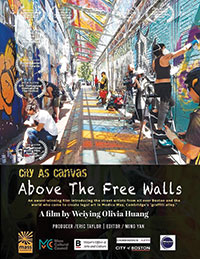 *
*
I have had the pleasure to interview former Somerville resident and documentary filmmaker Olivia Huang a number of times. And I have even appeared in a documentary she did about the Grolier Poetry Book Shop some years ago. Now Huang turns her discerning eye on Graffiti Alley in Cambridge, with her new documentary, City as Canvas: Above the Free Walls. I attended a screening of the film, and later chatted with Huang.
Doug Holder: You have lived in Somerville for a while, as an artist. How did you find the environment?
Olivia Huang: Somerville was my home when I first moved to Boston, and many of my first experiences with the artistic community were in the five years I lived there. I volunteered at the Somerville Museum hanging artwork, photographing events at the Armory.
In 2017, working on my first documentary film about the Grolier Poetry Bookshop, many of the poets and writers who appeared in the film, Gloria Mindock, Patrick Sylvain, yourself, were all from Somerville.
I always found the environment of Somerville to be vibrant, supportive, and encouraging, and I am still very close to the artists I worked with in the past.
DH: Why did you choose Graffiti Alley as a subject for your documentary?
OH: I used to commute from the Central Square T station, so walking through Modica Way/Graffiti Alley became a daily event. I was always struck by how frequently the paintings changed, how talented the artists were, and eventually I got to know some well enough to bring my camera. So, the idea to make a documentary about the alley, the artists, their artwork, was simply a natural progression. And I appreciated that this was a space where anyone could come to paint and to practice.
Late one night passing through the alley, I met a painter and I asked why he’d chosen to work at that hour. He told me he was a construction worker, and that for him painting was his healing therapy, so he found whatever time that was available. It was stories like this that continued to inspire the documentary.
The other realization I had working on the film was the amount of money cities spend to remove illegal graffiti and wondered if “there were more free walls” for painting, people might prefer to paint on a legal surface.
DH: What challenges did you face in creating this documentary?
OH: The first challenge was coordinating with the artists so that I could shoot them more than once. I’d leave them my contact information so I would know when they were painting again, but most of the time I would have to wait until I saw them in the alley again. Some days I would get a lot of great footage, and other days I’d just sit at Cafe Nero with my camera and tripod, waiting for some to show up and start painting.
The other challenge was after having collected enough footage, I moved on to the editing process, confident in my material, and the artists who were to be heavily featured in the film. At the last minute however, one of the artists changed his mind about his appearance in the film, even after having signed a release form. Eventually he agreed to allow me to use footage of him interacting with the other artists, but his refusal forced me to change the shape of my film.
DH: Karl Stephan, a Somerville artist, was involved in this project. What was his role?
OH: Many of the artists I interviewed lacked any formal art training, so as I edited the film, I wanted to add Karl’s voice and perspective as a studio artist, as an educator with an MFA who also knew Modica Way and many of its artists personally. Karl was one of the first to photograph and document the alley and curated two shows combining the work of both street and studio art, so his knowledge and experience was of great help.
DH: The paintings the painters sprayed on the walls were eventually covered up by other artists’ works. How did they reconcile this after they put all that hard work into it?
OH: What I learned from conversations with the artists is that they all have different reasons for painting there. Some are practicing their skills, others are creating a piece for their work portfolio, and some are just there to enjoy the creative process, happy to have a wall available to them instead of searching for another spot.
DH: What are your goals when you made this documentary?
OH: The goal of City As Canvas, I really want people to watch the film and learn about the legal walls in the community. The artist and the communities can appreciate each other. Encourage the creative enthusiastic to paint legally and without fear. Currently, the film has a series screening around the greater Boston area, which included the screening in various branches at Boston Public library, Simmons University, 2 life communities and Cambridge Public library. It was supported in part by an “Expand Massachusetts Stories” grant from Mass Humanities that made the screenings/workshops available.
DH: What do you have planned for future work?
OH: My next project is actually an extension of the City As Canvas film in that it is focused more broadly on “public art.” I very much hope that film will be seen both by Modica Way artists who can see themselves as part of the “public art community,” and so communities can have a greater appreciation for the artists whose creativity improves the aesthetic quality of their neighborhood.












Reader Comments